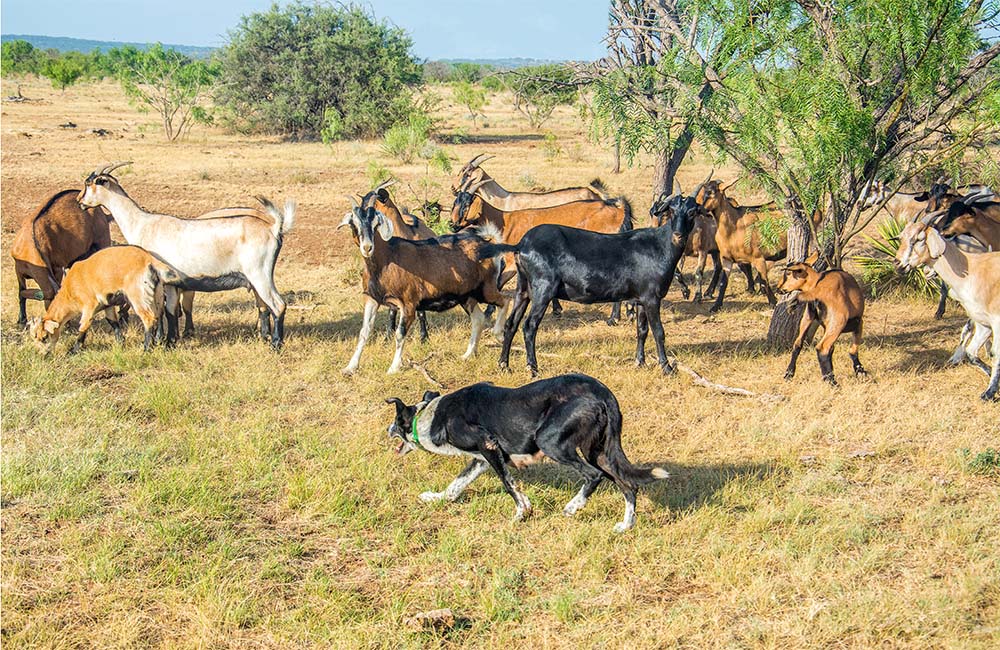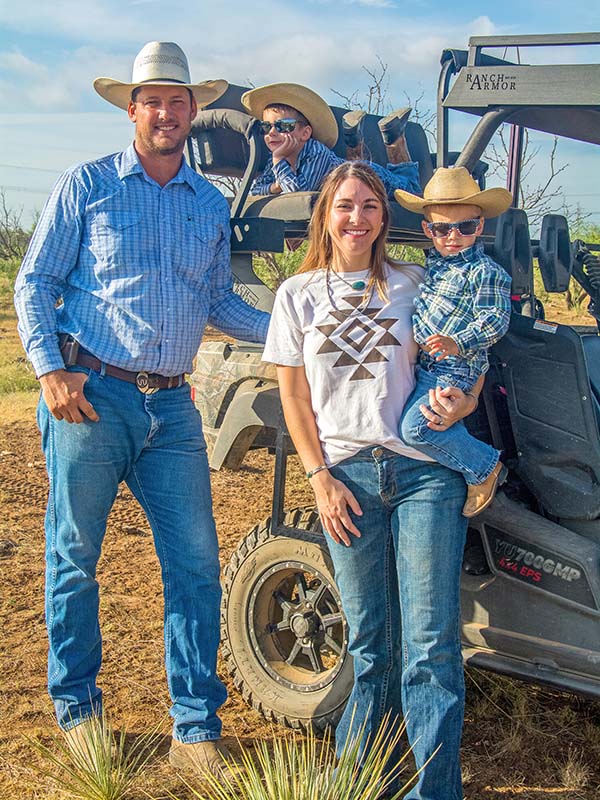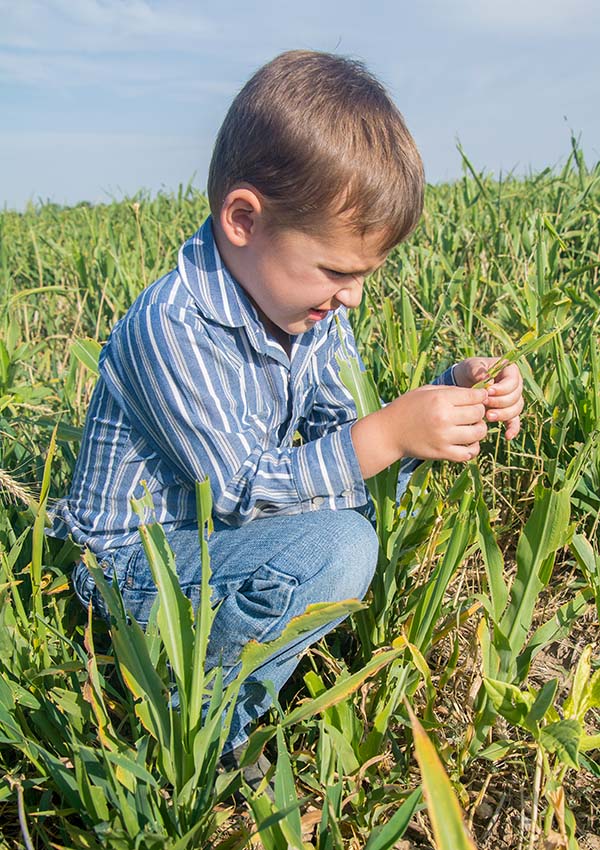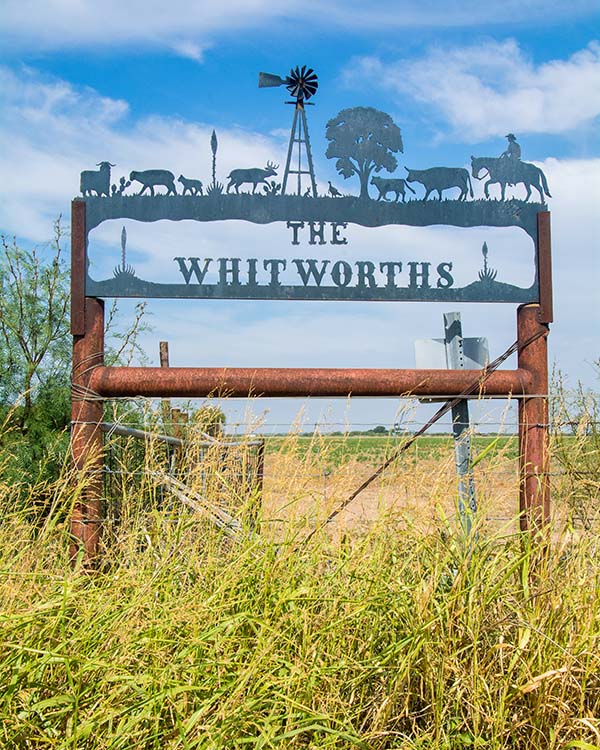
Photo by Sheryl Smith-Rodgers
Border collie Bell works a group of Kensing Spanish goats at the Whitworth Ranch in west-central Texas. With several thousand head of sheep and goats, the Whitworths rely on their dogs to help herd the livestock.
When Carl and Emily Whitworth took over his grandfather’s ag operation near Doole in west-central Texas, they knew they would have to make some changes.
The sixth-generation producers respect the traditional ways of working the land and raising goats and sheep. But they also want to pass their agricultural legacy on to the next generation.
“In our business, there’s too much looking back instead of looking forward,” Carl says. “We want to make farming and ranching work in 2022 — and beyond.”

Photo by Sheryl Smith-Rodgers
Carl and Emily Whitworth have implemented sustainable farming and ranching practices to keep their land healthy for future generations, including sons Levin, on the four-wheeler, and Waylon.
To ensure that happens, the young couple has turned to more sustainable farming practices and diversified their operation.
Common goat ranching background
Now in their eighth year of ag production, Carl and Emily raise Kensing Spanish goats, fine-wool club lambs, Angus–Saler crossbred “heifer bulls,” cotton and wheat on the century-old Whitworth Ranch and leased acreage. They also graze goats out of state.
Goat ranching is part of their joint heritage. Emily was reared on her family’s Earwood Ranch south of Sonora, Texas, where they produced Angora goats and fine mohair. Fifty miles east, Carl grew up helping his father, David Whitworth, to ranch and run Spanish goats near Junction.
They knew each other through 4-H and sports activities and started dating at Texas A&M University. After graduating with animal science degrees in 2012, they married and moved in with Carl’s grandfather, the late V.C. Whitworth, on the Whitworth Ranch.
“‘Papal’ was 88 at the time and still running the place,” Carl says. “So, we partnered with him and helped him with his sheep, goats, cattle and crops. But we didn’t have a lot of say in how things were done.”
That changed two years later when V.C. retired and left Carl and Emily to manage the place.
“We went from three plows a year to one plow, and then no-till and cover crops. If your soil has been getting fertilizer, you don’t just stop. As you build organic matter and healthier soil, you can do away with fertilizers and herbicides.”
– Carl Whitworth
Cover crops and zero tillage

Photo by Sheryl Smith-Rodgers
Levin Whitworth checks out the warm-season mix of sorghum-sudangrass, pearl millet, cowpeas, buckwheat and sunflowers his parents sow as cover crops.
For years, farmland on the Whitworth Ranch was plowed for wheat and cotton and left fallow between crops. To revitalize the soil and reduce farming costs, the couple transitioned to more regenerative practices — cover crops and zero tillage.
By adopting conservation tillage practices, they've cut down on labor, fuel, fertilizers and equipment costs. Less plowing also means less erosion and more nutrients in the soil. But all that didn’t happen right away.
“We went from three plows a year to one plow, and then no-till and cover crops,” Carl says. “If your soil has been getting fertilizer, you don’t just stop. As you build organic matter and healthier soil, you can do away with fertilizers and herbicides.
“It’s a process to move away from plowing,” he adds. “I’ve learned that you have to do something for five or so years. If you’re trying for a quick return, then you’re headed for trouble.”
To further boost their land’s productivity, the Whitworths combine no-till with cover crops. As part of their annual rotation, they plant a warm-season mix of sorghum-sudangrass, pearl millet, cowpeas, buckwheat and sunflowers. The cowpeas are a legume that fixes nitrogen in the soil. The sorghum and other plants build organic matter, which feeds microbes and boosts the soil’s water-holding capacity.
“We don’t crop anything back-to-back anymore,” Carl adds. “We plant wheat, then harvest it and plant our cover crop. We let that grow up and winter-kill, then graze it all winter and let the animals push the crop residue into the ground to build organic matter. Then we plant cotton in the summer and start the rotation over again.”
Lending partnerships
When 330 acres of nearby farmland came up for sale in 2018, the Whitworths jumped on it. They qualified for a low-interest Farm Service Agency (FSA) loan for producers who are in their first 10 years of operation.
However, the FSA loan wasn’t enough to cover the purchase, so they contacted Jeff Bedwell, Central Texas Farm Credit’s branch manager in Brady. Despite some red tape and a brief government shutdown, Bedwell completed the paperwork in time to close the deal.

Photo by Sheryl Smith-Rodgers
For six generations, the Whitworths have raised goats, sheep and cattle on the western fringe of the Texas Hill Country. Today, they also pasture goats on ranches out of state, where the animals help control brush and weeds.
“The FSA offers the option of a joint financing partnership,” Bedwell explains. “They do half the loan, and we do the other half. Carl and Emily were perfect candidates for the program, which makes it easier for beginning producers like them to get started.”
Bedwell’s enthusiasm for the Whitworths’ operation still impresses them.
“Jeff has been great to work with,” Emily says. “From the start, he believed in what we were doing. It’s been a great partnership.”
Spanish goats a priority
The Kensing bloodline of hardy meat goats is named for Carl’s great-uncle, the late Robert Kensing of Menard, Texas. In 1972, Kensing began selectively breeding and culling his purebred Spanish goats. Today David and Carl manage his foundation goat herd.
“Of everything we do on this ranch, Kensing Spanish goats are our biggest focus,” Carl says. “We partner with my father and sell seedstock all over the nation. We also raise mutton for commercial markets.”
Together, David, Carl and Emily have goat partnerships in Texas, Wyoming and Oklahoma, where landowners welcome the goats to help control brush and weeds. One of their goat herds grazes at the Noble Research Institute in Oklahoma. The Whitworths estimated they would breed 4,000 nannies this fall.
To protect their herds from predators, they use more than 40 guard dogs. They also rely on professional herders wherever there’s no goat-proof fencing. Since 2017, they’ve hired Peruvian sheepherders on H-2A work visas to look after the goats that they place on leased cattle ranches for weed and brush control.
“Up north, that’s how they herd sheep and goats on thousands of acres with no fences,” Carl says. “The Peruvians have campers and stay with the herds. We’re trying to figure out how to get the ranchers to pay us for brush control, instead of us paying for pasturage.”
That’s the case in Wyoming, where the Whitworths get paid for grazing their goats from spring to fall while the animals remove invasive leafy spurge on cattle ranches.
Family time
With farming and ranching enterprises to manage, employees to coordinate and leased properties to keep up with, the couple is always on the go. They involve their young sons, Levin and Waylon, in their activities whenever possible.
“Every day’s different,” says Carl, who also custom farms and builds fences. “We don’t have a set schedule. This afternoon, I’m selling two bulls. Then I’m going to weld on a plow and unroll some fencing. Whenever I can, I take the boys with me.”
Emily smiles.
“We grew up doing this,” she says. “We love it. It’s a lifestyle more than our work. So we want to have something for our boys to come back to if they want to. That’s really important to us.”
— Sheryl Smith-Rodgers